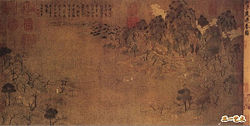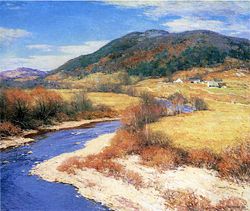Landscape painting
- For the art of designing external spaces, see landscape architecture. For landscape photography, see nature photography.
Landscape art depicts scenery such as mountains, valleys, trees, rivers, and forests. Sky is almost always included in the view, and weather usually is an element of the composition. In the first century C.E., Roman frescoes of landscapes decorated rooms that have been preserved at Pompeii and Herculaneum. Traditionally, landscape art depicts the surface of the earth, but there are other sorts of landscapes, such as moonscapes, for example.
The word landscape is from the Dutch, landschap meaning a sheaf, a patch of cultivated ground. The word entered the English vocabulary of the connoisseur in the late 17th century.
Early in the fifteenth century, landscape painting was established as a genre in Europe, as a setting for human activity, often expressed in a religious subject, such as the themes of the Rest on the Flight into Egypt, the Journey of the Magi, or Saint Jerome in the Desert.
The Chinese tradition of "pure" landscape, in which the minute human figure simply gives scale and invites the viewer to participate in the experience, was well established by the time the oldest surviving ink paintings were executed.
In Europe, as John Ruskin realized,[1] and Sir Kenneth Clark brought to view, landscape painting was the "chief artistic creation of the nineteenth century", with the result that in the following period people were "apt to assume that the appreciation of natural beauty and the painting of landscape is a normal and enduring part of our spiritual activity"[2] In Clark's analysis, underlying European ways to convert the complexity of landscape to an idea were four fundamental approaches: by the acceptance of descriptive symbols, by curiosity about the facts of nature, by the creation of fantasy to allay deep-rooted fears of nature and by the belief in a Golden Age of harmony and order, which might be retrieved.
As explorers, naturalists, mariners, merchants and settlers arrived on the shores of Atlantic Canada in the early centuries of its exploration, they were confronted by what they saw as a hostile and dangerous environment and an unforgiving sea. These Europeans tried to cope with the daunting new land by mapping, recording and claiming it as their own. Their understanding of the specific nature of this land and its inhabitants varied greatly, with observations ranging from highly accurate and scientific to outlandish or fantastic. These observations are documented in the landscape artworks they produced. The best examples of Canadian landscape art can be found in the works of the Group of Seven.[3]
In a book on the phenomena of Krakatoa, (The Day the World Exploded: August 27, 1883 by Simon Winchester) the volcanic eruption that could be heard clear across the world, the writer states that the magnificent sunsets recorded by the Impressionists and great English painter William Turner, could be attributed to the dust and debris in the atmosphere, following that incredible event, travelling around the earth for many years after.
Related -scapes
- Vedute is the Italian term for view, and generally used for the painted landscape, often cityscapes which were a common 18th century painting thematic.
- Skyscapes or Cloudscapes are depictions of clouds, weatherforms, and atmospheric conditions.
- Moonscapes show the landscape of a moon.
- Seascapes depict oceans or beaches.
- Riverscapes depict rivers or creeks.
- Cityscapes or townscapes depict cities (urban landscapes).
- Hardscapes are paved over areas like streets and sidewalks, large business complexes and housing developments, and industrial areas.
- Aerial landscapes depict a surface or ground from above, especially as seen from an airplane or spacecraft. (When the viewpoint is directly overhead, looking down, there is of course no depiction of a horizon or sky.) This genre can be combined with others, as in the aerial cloudscapes of Georgia O'Keeffe, the aerial moonscapes of Nancy Graves, or the aerial cityscapes of Yvonne Jacquette.
- Inscapes are landscape-like (usually surrealist or abstract) artworks which seek to convey the psychoanalytic view of the mind as a three-dimensional space. [For sources on this statement, see the Inscape (visual art) article.]
Notes
- ↑ Modern Painters, volume three, contains the relevant section, "Of the novelty of landscape".
- ↑ Clark, Landscape into Art, preface.
- ↑ "Landscapes" in Virtual Vault, an online exhibition of Canadian historical art at Library and Archives Canada
See also
- American Barbizon School
- Barbizon School
- Heidelberg School (Australia)
- Hudson River School
- Luminism
- Plein Air painting
- Shanshui
- Veduta
- White Mountain art
- Aerial perspective
- Group of Seven
- Hoosier Group
ReferencesISBN links support NWE through referral fees
- Nils Büttner, "Landscape Painting. A History", New/York/London 2006
- Clark, Sir Kenneth, Landscape into Art, 1949 : the Slade Lectures.
- Dreikausen, Margret, "Aerial Perception: The Earth as Seen from Aircraft and Spacecraft and Its Influence on Contemporary Art" (Associated University Presses: Cranbury, NJ; London, ; Mississauga, Ontario: 1985) ISBN 0-87982-040-3
- Hirsch, Sharon L., "Landscape: the Grand tradition"] (Exhibition catalogue text) Dickinson University (on-line text)
- Pavel Machotka, Cezanne : Landscape into Art
- Wilton, Andrew; T J Barringer; Tate Britain (Gallery); Pennsylvania Academy of the Fine Arts.; Minneapolis Institute of Arts. American sublime : landscape painting in the United States, 1820-1880 (Princeton, NJ : Princeton University Press, 2002)
- Virtual Vault, an online exhibition of Canadian historical art at Library and Archives Canada
Credits
New World Encyclopedia writers and editors rewrote and completed the Wikipedia article in accordance with New World Encyclopedia standards. This article abides by terms of the Creative Commons CC-by-sa 3.0 License (CC-by-sa), which may be used and disseminated with proper attribution. Credit is due under the terms of this license that can reference both the New World Encyclopedia contributors and the selfless volunteer contributors of the Wikimedia Foundation. To cite this article click here for a list of acceptable citing formats.The history of earlier contributions by wikipedians is accessible to researchers here:
The history of this article since it was imported to New World Encyclopedia:
Note: Some restrictions may apply to use of individual images which are separately licensed.


